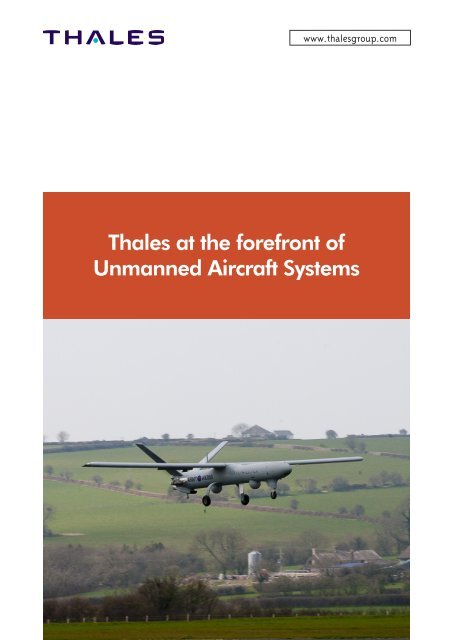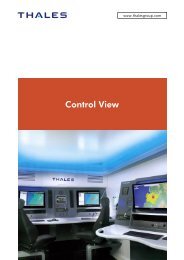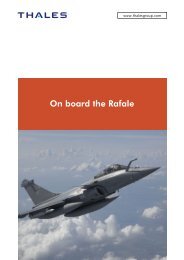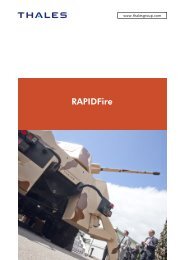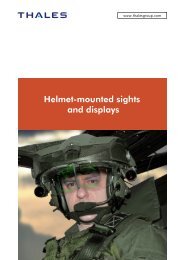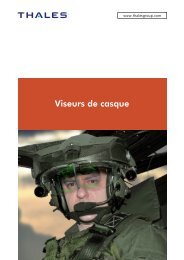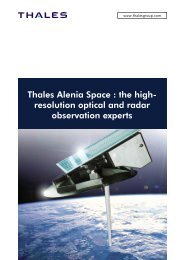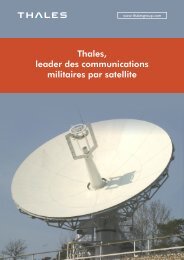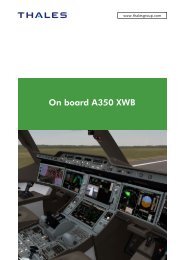Thales at the forefront of Unmanned Aircraft Systems - Thales Group
Thales at the forefront of Unmanned Aircraft Systems - Thales Group
Thales at the forefront of Unmanned Aircraft Systems - Thales Group
Create successful ePaper yourself
Turn your PDF publications into a flip-book with our unique Google optimized e-Paper software.
<strong>Thales</strong> is <strong>at</strong> <strong>the</strong> <strong>forefront</strong> <strong>of</strong> innov<strong>at</strong>ion in <strong>Unmanned</strong><strong>Aircraft</strong> <strong>Systems</strong> (UAS) and is a leader and key partneron <strong>the</strong> intern<strong>at</strong>ional stage developing new programmeswithin this growing domain. <strong>Thales</strong> has more than 40years <strong>of</strong> experience in manned and unmanned airbornesurveillance systems and as such is ideally placed to lead orprovide a strong contribution in <strong>the</strong> development <strong>of</strong> currentand future UAS programmes.UAS are playing an ever more important role in defenceplanning. They provide situ<strong>at</strong>ion awareness th<strong>at</strong> allowscommanders to make better informed decisions andreact accordingly. These autonomous systems not onlyhave significant potential to save lives because <strong>the</strong>y areuninhabited aircraft, but also because <strong>the</strong>y can protectforces on <strong>the</strong> ground and precisely hone in on enemytargets, <strong>the</strong>reby minimizing <strong>the</strong> thre<strong>at</strong> <strong>of</strong> coll<strong>at</strong>eral damage.UAS have <strong>the</strong> added advantage <strong>of</strong> providing long-termpersistent capabilities and flexible high performance. While<strong>the</strong>se aircraft have both military and civil applic<strong>at</strong>ions,<strong>Thales</strong> is supporting intern<strong>at</strong>ional regul<strong>at</strong>ory initi<strong>at</strong>ives,which are being driven forward in prepar<strong>at</strong>ion for UASintegr<strong>at</strong>ion into civil airspace, for which <strong>the</strong>ir potentialapplic<strong>at</strong>ions are endless.<strong>Thales</strong> is <strong>the</strong> prime contractor for Europe’s largest UASprogramme, W<strong>at</strong>chkeeper, and has designed a full range<strong>of</strong> avionics and sensor payloads, d<strong>at</strong>a-links and missionsystems for UAS. It is also a key partner in several importantintern<strong>at</strong>ional projects aimed <strong>at</strong> fostering Europeanautonomy in this sector.<strong>Thales</strong> UAS technologies and system capabilities not onlyhave a successful record in <strong>the</strong><strong>at</strong>res <strong>of</strong> oper<strong>at</strong>ion, but<strong>the</strong> company has proven its ability to manage complexprogrammes in this field.Tactical UAS<strong>Thales</strong> is a global leader in <strong>the</strong> field <strong>of</strong> Tactical UAS andhas a strong pedigree in current Tactical UAS systems andtechnologies. Hermes 450 and W<strong>at</strong>chkeeper are two keyprogrammes for support to Armed Forces in oper<strong>at</strong>ions.These systems fill <strong>the</strong> capability gap between short-rangemini-UAVs and long-range pl<strong>at</strong>forms, such as <strong>the</strong> extendedendurance MALE and HALE UAS, by combining flexibility withlonger endurance.Tactical UAS are used for Situ<strong>at</strong>ional Awareness, Surveillance,Reconnaissance, Target Acquisition, B<strong>at</strong>tle DamageAssessment and Influence activities.<strong>Thales</strong> brings subsystem design, manufacture and systemsintegr<strong>at</strong>ion experience toge<strong>the</strong>r to <strong>of</strong>fer a complete scalabletactical UAS solution th<strong>at</strong> can be tailored to <strong>the</strong> needs <strong>of</strong> eachcustomer.Hermes 450In 2007, <strong>Thales</strong> was awarded an Urgent Oper<strong>at</strong>ionalRequirement (UOR) contract by <strong>the</strong> UK Ministry <strong>of</strong> Defence(MoD) to supply UK forces on current oper<strong>at</strong>ions withHermes 450 Tactical UAS to provide an urgently needed,enhanced intelligence, surveillance, target acquisitionand reconnaissance (ISTAR) capability.<strong>Thales</strong> Innov<strong>at</strong>ive Service provision provides “ISTAR by <strong>the</strong>Hour” to support UK forces. <strong>Thales</strong> provides <strong>the</strong> Hermes450 UAS and training for UK MOD for oper<strong>at</strong>ions andmaintenance along with Contract logistics support andflight line support in oper<strong>at</strong>ional <strong>the</strong><strong>at</strong>re.Hermes 450 unmanned air vehicle has achieved over85,000 flying hours supporting UK forces as a b<strong>at</strong>tlewinningcapability and is confirmed as one <strong>of</strong> <strong>the</strong> leadingISTAR pl<strong>at</strong>forms delivering <strong>the</strong> lion’s share <strong>of</strong> ISTARsupport to <strong>the</strong> UK Forces.The UAS is now flying in support <strong>of</strong> oper<strong>at</strong>ions, providingpersistent ISTAR coverage and delivering very high visualand IR imagery, day and night. Imagery is available in<strong>the</strong> GCS, rebroadcast to Joint HQs and is available tosoldiers on <strong>the</strong> ground via Remote Viewing Terminals.Additional Tactical UAS have been delivered to both<strong>the</strong><strong>at</strong>res and ramped up to full oper<strong>at</strong>ing capability,providing continuous ISTAR over a large area.W<strong>at</strong>chkeeper<strong>Thales</strong> is <strong>the</strong> prime contractor and systems integr<strong>at</strong>or forW<strong>at</strong>chkeeper, currently <strong>the</strong> world’s most sophistic<strong>at</strong>edtactical ISTAR system and Europe’s largest UASprogramme. This programme is part <strong>of</strong> <strong>the</strong> UK MoD’sdrive to improve protection for its forces in <strong>the</strong><strong>at</strong>res <strong>of</strong>oper<strong>at</strong>ion, where <strong>the</strong>se systems are set to give commandersa distinct tactical and str<strong>at</strong>egic advantage by carrying outintelligence, surveillance and reconnaissance activities.The W<strong>at</strong>chkeeper programme is designed to be part<strong>of</strong> a highly networked system th<strong>at</strong> allows for gre<strong>at</strong>erdissemin<strong>at</strong>ion and exploit<strong>at</strong>ion <strong>of</strong> intelligence, and will bea key component <strong>of</strong> <strong>the</strong> UK’s network enabled capability(NEC).W<strong>at</strong>chkeeper flew for <strong>the</strong> first time in <strong>the</strong> UK on April14, 2010, taking <strong>of</strong>f from dedic<strong>at</strong>ed facilities <strong>at</strong>ParcAberporth in West Wales for a 20-minute flight.This was <strong>the</strong> first milestone in a long-term programmeto demonstr<strong>at</strong>e th<strong>at</strong> <strong>the</strong> system meets <strong>the</strong> robust safetyand airworthiness criteria required to fly UAVs initially onranges and segreg<strong>at</strong>ed airspace in <strong>the</strong> UK.W<strong>at</strong>chkeeper is <strong>the</strong> only Programme designed, built andtested to meet European civil & military UAV airworthinesscriteria. This gives <strong>the</strong> core system/pl<strong>at</strong>form considerablepedigree when it comes to export potential. It is alsocertified by MoD airworthiness authority.
Classroom based training for W<strong>at</strong>chkeeper began in May2011 <strong>at</strong> Larkhill, Wiltshire, <strong>at</strong> <strong>the</strong> purpose-built UAV trainingfacility.<strong>Thales</strong>’s innov<strong>at</strong>ive approach to ISTAR service provisionnot only s<strong>at</strong>isfies a fast and effective solution to an urgentoper<strong>at</strong>ional need for persistent image intelligence <strong>at</strong> <strong>the</strong>front-line, but also paves <strong>the</strong> way for <strong>the</strong> enhanced thirdgener<strong>at</strong>ion ISTAR capability th<strong>at</strong> <strong>the</strong> <strong>Thales</strong> W<strong>at</strong>chkeeperprogramme will eventually provide.The W<strong>at</strong>chkeeper system, which is being produced andintegr<strong>at</strong>ed <strong>at</strong> U-TacS (UAV Tactical <strong>Systems</strong> Ltd) site in Leicester,UK, delivers accur<strong>at</strong>e and timely ISTAR inform<strong>at</strong>ion to <strong>the</strong>decision makers <strong>at</strong> all levels <strong>of</strong> Command. W<strong>at</strong>chkeeper hasa scalable architecture and will be deployed in a range <strong>of</strong>configur<strong>at</strong>ions to meet customer needs. The basic GroundControl St<strong>at</strong>ion (GCS) will control three air vehicles toprovide persistent ISTAR to a tactical commander. At its mostcomplex, W<strong>at</strong>chkeeper can be deployed with multiple GCS’sand air vehicles with mobile command centres. These workto coordin<strong>at</strong>e multiple deployed units and provide a majorinput to ISTAR capabilities in a major conflict. W<strong>at</strong>chkeepercan provide 24-hour all we<strong>at</strong>her dual payload, multi-missionISTAR capability.<strong>Thales</strong> will also provide service support for <strong>the</strong> W<strong>at</strong>chkeeperprogramme to <strong>the</strong> UK MoD, which awarded <strong>the</strong> companyan initial three-year support contract in early 2010. Theperformance-based Contractor Logistics Support (CLS)service is set to provide spares and repairs, technical support,along with <strong>the</strong> availability <strong>of</strong> <strong>the</strong> W<strong>at</strong>chkeeper trainingfacility. <strong>Thales</strong> will deliver this service with <strong>the</strong> support <strong>of</strong>its key partners and supply chain, established during <strong>the</strong>W<strong>at</strong>chkeeper development and production programme.VTOLSVertical Take<strong>of</strong>f and Landing <strong>Systems</strong>, or VTOLS ie helicopterUAS, are becoming a must for future UAS, as hostileconditions in <strong>the</strong><strong>at</strong>res <strong>of</strong> oper<strong>at</strong>ion sometimes result ina lack <strong>of</strong> proper landing strips. These systems also makedeck-landing a possibility for rotorcraft UAVs, <strong>the</strong>reby giving<strong>the</strong>se vehicles a wider range <strong>of</strong> applic<strong>at</strong>ions. <strong>Thales</strong> is <strong>at</strong> <strong>the</strong><strong>forefront</strong> <strong>of</strong> such innov<strong>at</strong>ion in UAV systems <strong>at</strong> <strong>the</strong> Europeanlevel.In 2010 In France, <strong>Thales</strong> supported a series <strong>of</strong> comprehensivetrials to assess <strong>the</strong> oper<strong>at</strong>ional advantages <strong>of</strong> a VTOL (VerticalTake<strong>of</strong>f and Landing) UAS. The French Defence ProcurementAgency (DGA) had selected Schiebel’s unmanned aerialsystem Camcopter S-100 for <strong>the</strong>se trials.This contract was a fur<strong>the</strong>r step forward in <strong>the</strong> Europeanroadmap for UAV systems and confirmed <strong>Thales</strong>’s expertisein airworthiness and flight certific<strong>at</strong>ion, as well as itsinvolvement in French and European air safety regul<strong>at</strong>ions,and its European leadership in <strong>the</strong>se UAV systems.<strong>Thales</strong> has successfully lead <strong>the</strong> Technical Design StudyD2AD for <strong>the</strong> design and demonstr<strong>at</strong>ion <strong>of</strong> an autom<strong>at</strong>ictake-<strong>of</strong>f, landing and deck landing system for rotorcraftUAVs, set to be a vital component <strong>of</strong> future tactical UASprogrammes.Sea trials took place in September and October 2012with 30 successful autom<strong>at</strong>ic take<strong>of</strong>fs and landings <strong>of</strong> aSchiebel’s Campcopter equipped with D2AD.The system has been tested under sea conditions up tolevel 3, wind (30kts), rain. With its high landing precisionD2AD has proved th<strong>at</strong> it paves <strong>the</strong> way for future navalVTOL UAV.MALE UASThe long endurance capabilities <strong>of</strong> MALE UAS make <strong>the</strong>mideal for <strong>the</strong> surveillance <strong>of</strong> <strong>the</strong><strong>at</strong>res <strong>of</strong> oper<strong>at</strong>ion andfor zone reconnaissance. These systems can be used toidentify <strong>the</strong> position <strong>of</strong> enemy forces, <strong>the</strong> mass movement<strong>of</strong> non-comb<strong>at</strong>ant popul<strong>at</strong>ions, <strong>the</strong> st<strong>at</strong>e <strong>of</strong> in-<strong>the</strong><strong>at</strong>reinfrastructures, as well as to establish lists <strong>of</strong> targets.<strong>Thales</strong> is a key European player in unmanned andmanned surveillance systems – in particular, <strong>the</strong> companybenefits from solid experience in <strong>the</strong> inform<strong>at</strong>ion-centricoper<strong>at</strong>ions <strong>of</strong> W<strong>at</strong>chkeeper and manned C4ISTARsystems, which it could draw on to produce <strong>the</strong> most costeffectiveimplement<strong>at</strong>ion <strong>of</strong> intelligent mission systemcapabilities within <strong>the</strong> MALE UAS system architecture.<strong>Thales</strong> sees <strong>the</strong> combin<strong>at</strong>ion <strong>of</strong> its experience andexpertise in C4ISTAR, avionics, unmanned aerial systems,certific<strong>at</strong>ion, communic<strong>at</strong>ions and security, b<strong>at</strong>tlefieldand exploit<strong>at</strong>ion, with <strong>the</strong> airframer, as providing a clearpotential value for <strong>the</strong> development <strong>of</strong> a European MALEUAS.UCAV<strong>Thales</strong>’s technologies are onboard <strong>the</strong> nEUROn, Europe’sunmanned comb<strong>at</strong> air vehicle (UCAV) stealth technologydemonstr<strong>at</strong>or, which successfully completed its maidenflight on December 2012 from <strong>the</strong> Dassault Avi<strong>at</strong>ioncompany’s flight test base in Istres, sou<strong>the</strong>rn France, incollabor<strong>at</strong>ion with <strong>the</strong> flight test personnel <strong>of</strong> <strong>the</strong> Frenchdefense procurement agency (DGA).<strong>Thales</strong> technology made a substantial contribution tothis milestone event, thanks most notably to <strong>the</strong> highperformanceGPS hybrid military inertial system andanemometric probes. The inertial system contributesto <strong>the</strong> drone primary d<strong>at</strong>a (position and <strong>at</strong>titudes). Thehigh level <strong>of</strong> performance can be achieved thanks tohybridiz<strong>at</strong>ion algorithms and to <strong>the</strong> use <strong>of</strong> GPS andEGNOS signals. <strong>Thales</strong> also develops <strong>the</strong> communic<strong>at</strong>ion3
SIGAT is aimed <strong>at</strong> defining <strong>the</strong> appropri<strong>at</strong>e radio frequencyassoci<strong>at</strong>ed with command and control and payload d<strong>at</strong>alinks for future UAS integr<strong>at</strong>ion into general air traffic. <strong>Thales</strong>coordin<strong>at</strong>ed SIGAT, which was launched in 2009 and involved16 o<strong>the</strong>r industrial co-contractors and 7 subcontractors.SIGAT has helped set <strong>the</strong> stage for defining a commonEuropean position ahead <strong>of</strong> <strong>the</strong> 2012 WRC, which was asuccess for <strong>the</strong> UAS as new radi<strong>of</strong>requencies have beenalloc<strong>at</strong>ed for <strong>the</strong> oper<strong>at</strong>ion <strong>of</strong> UAS.MIDCASMIDCAS (Mid-air Collision Avoidance System) is <strong>the</strong>second project to emerge from <strong>the</strong> Air4All roadmap. Thislarge-scale project, grouping toge<strong>the</strong>r five European st<strong>at</strong>esand 13 industrial partners including <strong>Thales</strong>, is aimed <strong>at</strong>resolving “sense & avoid” challenges for UAVs. The projectarrangement has been signed by France, Germany, Italy,Spain and Sweden, with <strong>the</strong> industrial partnership headedby Saab.<strong>Thales</strong>, along with Sagem, is responsible for researching <strong>the</strong>“sense” function in <strong>the</strong> MIDCAS programme. These radarand sensor technologies play a decisive role in determining<strong>the</strong> UAS performance in terms <strong>of</strong> sensing aircraft in <strong>the</strong>surrounding airspace. <strong>Thales</strong> is responsible for work on <strong>the</strong>radar technology and on cooper<strong>at</strong>ive sensors (transponder,TCAS/traffic-alert and collision avoidance system, etc.), aswell as <strong>the</strong> fusion <strong>of</strong> d<strong>at</strong>a from all sensors.The MIDCAS initi<strong>at</strong>ive meets <strong>the</strong> collision avoidancechallenge, a key to being able to integr<strong>at</strong>e UAS in nonsegreg<strong>at</strong>edairspace. It also plays an essential role indeveloping both governmental and civil applic<strong>at</strong>ions <strong>of</strong> UAS,by developing a permanent solution guaranteeing flightsafety.ASTRAEAThe Autonomous <strong>Systems</strong> Technology Rel<strong>at</strong>ed AirborneEvalu<strong>at</strong>ion and Assessment (ASTRAEA) programme reflects<strong>the</strong> need for <strong>the</strong> UK and European aerospace sector toexploit <strong>the</strong> emerging and lucr<strong>at</strong>ive global civil market for<strong>Unmanned</strong> Air Vehicles (UAVs).The ASTRAEA programme is intended to open up UK civilairspace to <strong>the</strong> use <strong>of</strong> UAS by tackling <strong>the</strong> technologicaland regul<strong>at</strong>ory barriers th<strong>at</strong> currently prevent <strong>the</strong>ir routineoper<strong>at</strong>ion alongside manned aircraft.ASTRAEA is a unique collabor<strong>at</strong>ive programme betweenindustry and <strong>the</strong> public sector in <strong>the</strong> UK, with <strong>the</strong> goal <strong>of</strong>opening up civil airspace to unmanned air vehicles, focusingon <strong>the</strong> technologies, systems, facilities and proceduresth<strong>at</strong> will allow autonomous vehicles to oper<strong>at</strong>e safely androutinelyASTRAEA completed its first phase £32 million programmein 2009 and is finalizing a second 3 year phase <strong>of</strong> <strong>the</strong>programme in 2013.Key technologies and regul<strong>at</strong>ions include Autonomy,Human Factors, Sense and Avoid, SpectrumCommunic<strong>at</strong>ions and UAV Airworthiness, Crew licensing,Rules <strong>of</strong> <strong>the</strong> Air and Air Traffic ManagementA key element <strong>of</strong> a n<strong>at</strong>ional and global str<strong>at</strong>egy to buildon <strong>the</strong> collective capability in <strong>the</strong> realm <strong>of</strong> aerospacetechnology, with clear benefits in terms <strong>of</strong> improvedcompetitiveness, high-value jobs and sustainableeconomic growth.S<strong>at</strong>com studiesThe importance <strong>of</strong> s<strong>at</strong>ellite communic<strong>at</strong>ions isunanimously acknowledged due to <strong>the</strong> Beyond RadioLine Of Sight oper<strong>at</strong>ions. Such oper<strong>at</strong>ions will representa significant part <strong>of</strong> <strong>the</strong> missions, including for small RPA.Several studies, especially under <strong>the</strong> European SpaceAgency framework (e.g. ESPRIT), have been conducted todefine <strong>the</strong> most suitable s<strong>at</strong>ellite capabilities, answeringin particular <strong>the</strong> stringent safety needsSubsystems and equipment<strong>Thales</strong> has developed a range <strong>of</strong> subsystems andequipment to support its UAV capabilities, which can becustomised according to <strong>the</strong> needs <strong>of</strong> each client. Theseinclude current and future radar systems such as ATOLS,I-Master and ECUME, Avionics, Missile, Communic<strong>at</strong>ions.ATOLS<strong>Thales</strong>’s ATOLS (Autom<strong>at</strong>ic Take<strong>of</strong>f and Landing System)is a compact system th<strong>at</strong> ensures maximum safety, inall we<strong>at</strong>her conditions, during <strong>the</strong> critical take-<strong>of</strong>f andlanding phases <strong>of</strong> all UAV oper<strong>at</strong>ions. This high-precisionand long-range positioning sensor has been selected for<strong>the</strong> W<strong>at</strong>chkeeper programme. The system has removed<strong>the</strong> need for GPS coverage during take<strong>of</strong>f and landing,<strong>the</strong>reby reducing <strong>the</strong> risk <strong>of</strong> pilot error <strong>at</strong> a highly criticalflight phase. In its final landing phase, a ground-basedradar guides <strong>the</strong> W<strong>at</strong>chkeeper, which also has a ruggedundercarriage th<strong>at</strong> allows it to take<strong>of</strong>f from rougherterrain than standard runways.ATOLS has a non-intrusive standalone architecture th<strong>at</strong>ensures quick and simple integr<strong>at</strong>ion into UAV systems. Anumber <strong>of</strong> successful UAV qualific<strong>at</strong>ion flights – includingautom<strong>at</strong>ic take<strong>of</strong>fs, landings and touch-and-go – havebeen carried out with <strong>Thales</strong>’s ATOLS system onboard.I-MasterI-Master Radar is a lightweight tactical surveillance radarhas both Syn<strong>the</strong>tic Aperture (SAR) and Ground-MovingTarget Indic<strong>at</strong>or (GMTI) modes th<strong>at</strong> make it ideally suitedto detecting any type <strong>of</strong> movement and time sensitivetargets.5
Using I-Master, targets can be detected and imagery formedacross wide areas and extended ranges. It is effective inadverse we<strong>at</strong>her or where smoke or o<strong>the</strong>r obscurants mask<strong>the</strong> scene. The resulting imagery can be correl<strong>at</strong>ed with o<strong>the</strong>rimagery and intelligence sources, and analysed to provideor enhance target detection, classific<strong>at</strong>ion movement andp<strong>at</strong>tern-<strong>of</strong>-life history.O<strong>the</strong>r applic<strong>at</strong>ions include <strong>the</strong> ability to identify and mapareas <strong>of</strong> n<strong>at</strong>ural disaster, providing users with an accur<strong>at</strong>epicture <strong>of</strong> where help may be needed in very quick time. Theprocessed d<strong>at</strong>a output can be exploited in <strong>the</strong> air or d<strong>at</strong>alinkedto <strong>the</strong> ground.Flight and mission avionics capabilities<strong>Thales</strong> is <strong>the</strong> European leader for dual civil and militaryavionics providing leading edge solutions to <strong>the</strong> world mainaircraft manufacturer.Thus <strong>Thales</strong> is in <strong>the</strong> best position to <strong>of</strong>fer best insertioncapability, performance and competitiveness for <strong>the</strong> comingnew gener<strong>at</strong>ion <strong>of</strong> MALE and UCAV in a large multi-n<strong>at</strong>ionalpartnership.As European leader <strong>of</strong> avionics computing infrastructure,including hardware, secured and certified real-time oper<strong>at</strong>ingsystems, d<strong>at</strong>a dissemin<strong>at</strong>ion network, development toolsenvironment, <strong>Thales</strong> provides <strong>the</strong> most advanced solutionsuitable for highly demanding MALE and UCAV domain,and able to favor cooper<strong>at</strong>ive development. <strong>Thales</strong> willprovide affordable incremental solutions th<strong>at</strong> will supportplug-and-play capability for continuous evolution or n<strong>at</strong>ionalcustomiz<strong>at</strong>ion <strong>of</strong> <strong>the</strong> vehicle baseline.<strong>Thales</strong> is <strong>the</strong> sole European aeronautical manufacturer <strong>of</strong>civil and military GPS receivers and associ<strong>at</strong>ed anti-jammingantennas. <strong>Thales</strong> also supports GALILEO developmentby developing <strong>the</strong> first PRS receiver. Toge<strong>the</strong>r with inertialtechnologies based on in-house MEMS, ring laser gyros,and air d<strong>at</strong>a sensing, <strong>Thales</strong> provides outstanding hybridizednavig<strong>at</strong>ion solutions selected by Airbus and Embraer on<strong>the</strong>ir most recent programs. Thus <strong>Thales</strong> will secure MALEand UCAV localiz<strong>at</strong>ion in order to enable <strong>the</strong>ir safe usein non-segreg<strong>at</strong>ed airspace and in severely jammed warenvironment from taxy phase to mission area.Moreover, <strong>Thales</strong> will provide <strong>the</strong> MALE and UCAVmanufacturer a wide portfolio <strong>of</strong> avionics functions takingbest benefice <strong>of</strong> a long standing investment in a dualproduct policy for both civil and military applic<strong>at</strong>ions, likeparametric system health monitoring or flight managementfor constrained navig<strong>at</strong>ion.<strong>Thales</strong> will provide its expertise in human machine interfaceand concept <strong>of</strong> oper<strong>at</strong>ion to support emergence <strong>of</strong> a newgener<strong>at</strong>ion <strong>of</strong> remote control environment specificallycomp<strong>at</strong>ible with MALE long dur<strong>at</strong>ion flight stakes or UCAVsevere context <strong>of</strong> oper<strong>at</strong>ions.Lightweight Multi-role Missile (LMM)<strong>Thales</strong>s LMM (Lightweight Multi-role Missile) is a lowcost, lightweight, precision strike missile, which has beendesigned to be fired from a variety <strong>of</strong> light aircraft, UAVsor micro-lites.The missile has different guidance modes including laserbeam riding and/or laser design<strong>at</strong>ion to ensure precision<strong>at</strong>tack <strong>of</strong> targets with man-in-<strong>the</strong>-loop or autom<strong>at</strong>icguidance. The missile has a two-stage rocket motorsystem; <strong>the</strong> first stage provides a ‘s<strong>of</strong>t’ launch from <strong>the</strong>pl<strong>at</strong>form and <strong>the</strong> second stage boosts <strong>the</strong> missile up toa maximum velocity <strong>of</strong> > Mach 1.5. The fragmentingshaped charge warhead coupled with <strong>the</strong> laser proximityfuze provides excellent lethality against a wide range <strong>of</strong>targets, yet low coll<strong>at</strong>eral damage which is essential inbuilt-up and urban environments.A guidance device, safe arming unit and a set <strong>of</strong> canistershave been designed for integr<strong>at</strong>ion <strong>of</strong> LMM onboardvarious kind <strong>of</strong> fixed wing or rotary wing UAVs.CNI suite<strong>Thales</strong> <strong>of</strong>fers a comprehensive communic<strong>at</strong>ion productsportfolio. This encompasses STANAG compliantCommand and Control and Mission D<strong>at</strong>a Link for LOSand SATCOM Communic<strong>at</strong>ions which are mand<strong>at</strong>ory foreach type <strong>of</strong> UAV pl<strong>at</strong>forms. Communic<strong>at</strong>ions sub-systemsolutions are also provided for <strong>the</strong> various type <strong>of</strong> UASincluding a range <strong>of</strong> secured communic<strong>at</strong>ions servicesand inform<strong>at</strong>ion assurance.<strong>Thales</strong> has developed a small form factor IFF transponderwhich is key for being identified. Currently it oper<strong>at</strong>edsecurely with <strong>the</strong> mode 4, but new versions has beendeveloped th<strong>at</strong> embeds <strong>the</strong> mode 5 whose InitialOper<strong>at</strong>ing Capability will be pronounced in 2013 by<strong>the</strong> US. These new versions will also be able to integr<strong>at</strong>eCooper<strong>at</strong>ive Sense and Avoid capability, which are keysfor seamless integr<strong>at</strong>ion <strong>of</strong> UAV into Air Traffic.STANAG, interoperability and regul<strong>at</strong>ionsOne <strong>of</strong> <strong>the</strong> key issue for UAS pl<strong>at</strong>form is to fly on varioustype <strong>of</strong> <strong>the</strong><strong>at</strong>res. By adopting a product policy in line with<strong>the</strong> NATO STANAG and ITU regul<strong>at</strong>ions, <strong>Thales</strong> providescommunic<strong>at</strong>ions solutions which ease airworthiness, flightcertific<strong>at</strong>ion and interoperability. <strong>Thales</strong> was awardedseveral developments to improve <strong>the</strong> frequency spectrummanagement and is a major contributor in <strong>the</strong> NATOSTANAG working groups.C-ESM PayloadComplementary to EO/IR and Radar payloads, <strong>Thales</strong>ACS solution (Airborne COMINT solution) enlarge<strong>the</strong> field <strong>of</strong> capabilities <strong>of</strong> <strong>the</strong> UAV System. It is anadvanced and modular COMINT Payload which canbe integr<strong>at</strong>ed in Tactical UAV for targeting missionas well as MALE UAV for C-ESM and/or COMINT6
mission. The last development covers critical target <strong>of</strong>interest like GSM or HF and <strong>of</strong>fensive jamming <strong>at</strong>tackcapabilities.Tools for analyzing oper<strong>at</strong>ionalneeds<strong>Thales</strong> has developed interactive tools for clients, suchas armed forces, th<strong>at</strong> can be used to test <strong>the</strong> oper<strong>at</strong>ionalperformance <strong>of</strong> UAV systems and tailor <strong>the</strong>m to particularoper<strong>at</strong>ional needs. Among <strong>the</strong>se are <strong>the</strong> B<strong>at</strong>tlefieldTransform<strong>at</strong>ion Centre (BTC) for evalu<strong>at</strong>ing new technologiesand capabilities th<strong>at</strong> support armed forces, as well as <strong>the</strong>System Oriented UAV Labor<strong>at</strong>ory (SOUL) for testing andintegr<strong>at</strong>ing <strong>the</strong> human side <strong>of</strong> UAV piloting.BTC (B<strong>at</strong>tlefield Transform<strong>at</strong>ion Centre)While force protection has always been a major concernfor Armed Forces, recent conflicts have shown th<strong>at</strong> thre<strong>at</strong>scan evolve <strong>at</strong> a moment’s notice and it is <strong>the</strong>refore crucialto be able to adapt quickly. The simul<strong>at</strong>ion capacity <strong>of</strong>feredby <strong>the</strong> <strong>Thales</strong> B<strong>at</strong>tle Transform<strong>at</strong>ion Centre (BTC) allowsstakeholders to design, test and develop in record time thosesolutions capable <strong>of</strong> efficiently addressing new thre<strong>at</strong>s th<strong>at</strong>forces face on <strong>the</strong> ground.In <strong>the</strong> field <strong>of</strong> UAVs, <strong>the</strong> BTC <strong>of</strong>fers a collabor<strong>at</strong>ive centre <strong>of</strong>expertise th<strong>at</strong> is ideally suited to identifying and evalu<strong>at</strong>ingsolutions for a smooth and affordable transition to newnetwork-enabled capabilities. BTC enables customers toidentify <strong>the</strong>ir precise capability needs and <strong>the</strong> solutions<strong>Thales</strong> can provide to meet those needs. Coalitions andgovernments can work toge<strong>the</strong>r to evalu<strong>at</strong>e <strong>the</strong> impact <strong>of</strong>technology insertion on <strong>the</strong>ir tactics and interoperability.This collabor<strong>at</strong>ive process was used in <strong>the</strong> development <strong>of</strong> <strong>the</strong>W<strong>at</strong>chkeeper programme, from <strong>the</strong> initial conceptualis<strong>at</strong>ionthrough to <strong>the</strong> final fielded capability.SOUL (System Oriented UAV Labor<strong>at</strong>ory)<strong>Thales</strong> has developed a unique simul<strong>at</strong>ion environment on alabor<strong>at</strong>ory scale called SOUL. This lab is designed to recre<strong>at</strong>e<strong>the</strong> type <strong>of</strong> ground control st<strong>at</strong>ion from which UAV missionsare conducted. It is composed <strong>of</strong> several oper<strong>at</strong>or displaysdedic<strong>at</strong>ed to different mission phases. The goal is to assess<strong>the</strong> impact <strong>of</strong> human factors on <strong>the</strong> oper<strong>at</strong>ion <strong>of</strong> UAVs, aswell as to demonstr<strong>at</strong>e how relevant <strong>the</strong> solutions beingproposed are for oper<strong>at</strong>ional missions.The aim <strong>of</strong> SOUL is also to allow UAV oper<strong>at</strong>ors tooptimise use <strong>of</strong> <strong>the</strong> ground control st<strong>at</strong>ion. The labor<strong>at</strong>oryfe<strong>at</strong>ures <strong>the</strong> real-time transmission and sharing <strong>of</strong> tacticalsitu<strong>at</strong>ion d<strong>at</strong>a in 3D via a «multi-touch» screen fe<strong>at</strong>uringimmedi<strong>at</strong>e imaging d<strong>at</strong>a enhancement taken from allcontributing UAVs in <strong>the</strong> field. This tactical situ<strong>at</strong>ion d<strong>at</strong>a,stemming from <strong>the</strong> soldier on <strong>the</strong> ground or <strong>the</strong> commandcentre, is achieved in real time with communic<strong>at</strong>ion linksmanaged by selective compression systems th<strong>at</strong> focus ondetails about useful areas.<strong>Thales</strong> is one <strong>of</strong> <strong>the</strong> leading companies in Europe insurveillance systems (sensors, airborne computers,communic<strong>at</strong>ion, mission systems and dissemin<strong>at</strong>ionnetworks) involved in <strong>the</strong> most ambitious programmessuch as:Rafale sub-systems: Electronic Warfare, Active ElectronicScanned Array radar, computers, recce EO/IR…Tactical UAV systems – Hermes 450, W<strong>at</strong>chkeeper andVTOLsSIGINT : Transall Gabriel NG, Surveillance s<strong>at</strong>ellitesCommunic<strong>at</strong>ion : Communic<strong>at</strong>ion S<strong>at</strong>ellite (ATHENA-FIDUS ), D<strong>at</strong>alink (Recco NG), NATO ISAFGround Surveillance: Cougar horizon (SAR/GMTI Radar),Martime surveillance : Seaking Mk7 Airborne Missionsystem and SAR GMTI RadarNetworks : NATO ACSS LOC1<strong>Thales</strong> is positioned <strong>at</strong> <strong>the</strong> <strong>forefront</strong> <strong>of</strong> innov<strong>at</strong>ionfor UAS, addressing needs stemming directly fromoper<strong>at</strong>ional <strong>the</strong><strong>at</strong>res, while also helping to prepare civilairspace for <strong>the</strong>se systems. The company looks forwardto fur<strong>the</strong>r streng<strong>the</strong>ning partnerships in this excitingdomain.<strong>Thales</strong> – global leader in high performance mannedand unmanned systems and key partner in avionics,sensors and mission systems for UASPress Contact<strong>Thales</strong>, Media rel<strong>at</strong>ions – Defence AerospaceEmmanuelle Le Folemmanuelle.lefol@thalesgroup.comTel: +33 (0)6 82 65 64 347


